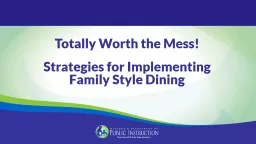PPT-Totally Worth the Mess! Strategies for Implementing
Author : yoshiko-marsland | Published Date : 2018-12-05
Family Style Dining Family Style Dining EMPOWERING FOSTER INDEPENDANCE BUILD CONFIDENCE PROMOTE LANGUAGE DEVELOP MOTOR SKILLS HEALTHY HABITS SOCIAL SKILLS LEARN
Presentation Embed Code
Download Presentation
Download Presentation The PPT/PDF document "Totally Worth the Mess! Strategies for I..." is the property of its rightful owner. Permission is granted to download and print the materials on this website for personal, non-commercial use only, and to display it on your personal computer provided you do not modify the materials and that you retain all copyright notices contained in the materials. By downloading content from our website, you accept the terms of this agreement.
Totally Worth the Mess! Strategies for Implementing: Transcript
Download Rules Of Document
"Totally Worth the Mess! Strategies for Implementing"The content belongs to its owner. You may download and print it for personal use, without modification, and keep all copyright notices. By downloading, you agree to these terms.
Related Documents














